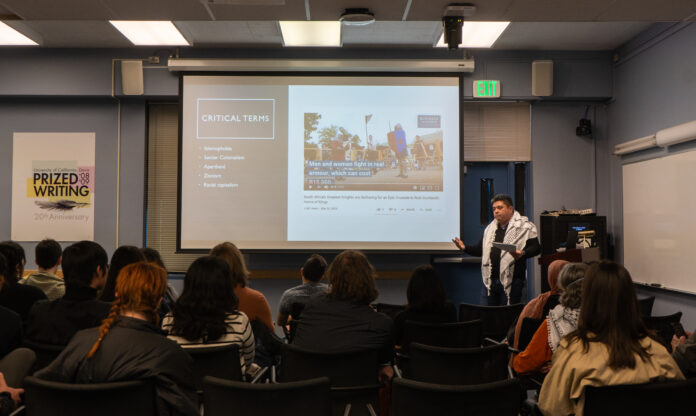The Stockton University professor discussed division within the academic field and the influence of The Crusades on modern-day settler colonialism
By SAVANNAH ANNO — arts@theaggie.org
On Nov. 1, the UC Davis Department of English hosted the first installment of its annual University English Department Speaker Series, welcoming Professor of Literature Adam Miyashiro from Stockton University in New Jersey.
With published works focusing on race, masculinity and biopolitics within the context of medieval studies, Miyashiro has spent much of his academic career bringing new perspectives to an academic field he describes as mostly Conservative.
“It’s a field that picks up on trends later than all others,” Miyashiro said. “When I started to work on race in the early 2000s, it was generally not considered to be a topic for study in the pre-modern period. We were constantly getting blocked by our field from talking about not only how race was constructed in the medieval period but also how medieval studies structures contemporary problems within race and settler colonialism.”
Beginning his presentation titled “From Iona to Al-Quds: How Medieval Studies Intersects with Palestine,” Miyashiro dove into a discussion of Palestinian history, its erasure within the academic field and how The Crusades are appropriated in modern-day militaries.
Miyashiro said Palestine has a bigger presence in the pre-modern world than most people may think.
“In contrast to many contemporary assertions, mainly by politicians, media figures and online commentators, Arab-Palestinian identity was already well known throughout the Muslim world in the medieval period,” Miyashiro said.
Miyashiro also said that while medievalists have largely avoided the role of Palestine in medieval literary and historical texts, the word “Palestine” has actually been used to identify both people and place for over 2,000 years, most likely originating from an ancient Egyptian word meaning “sea people.”
“Palestinian identity was quite common throughout Europe and the Arab world in this early period all the way up to what we know as The Crusades, a historic series of European military incursions in the Eastern Mediterranean which brought Palestine further into the European imaginary as a site of colonial aspirations,” Miyashiro said.
Miyashiro then went into depth on The Crusades (1095-1270) and their modern day representations in military, Zionist and alt-right ideologies, defining this influence as “Crusades appropriation.” The Crusades were organized by European Christians in an attempt to, in their perspective, liberate Jerusalem and the Holy Land from Muslim control through necessary violence.
Romanticized in the modern-day, Miyashiro reflected on the ways current colonial powers view themselves in relation to Crusaders in order to justify acts of violence, particularly within the ongoing occupation of Palestine.
“Crusades appropriation is a major component in how Zionism gets put into medieval spaces and how Crusade historians themselves have enabled the erasure of Palestinian identity,” Miyashiro said. “The appropriation intersects with settler colonial states to produce an erasure of colonial victims, notably Palestinians and other Muslims, who suffer at the hands of Western military regimes.”
Miyashiro presented multiple examples of this appropriation, which typically occurs through images and language that we may not notice being used on a regular basis within the digital landscape or by political figures at first.
Notable examples included a popular pro-Israel, alt-right meme that circulated in the late 2010s of a Crusader knight saying, “We will take Jerusalem.” This was in reference to George W. Bush referring to the U.S. invasion of Iraq as a crusade. The U.S. even has a Hawaii military base with an official sign of a large image of a Crusader knight. Miyashiro explains that these images, especially within the context of the U.S. government, assert a dominant Christian perspective and perpetuate Islamophobia.
“Medieval studies definitely has a deep complicity in a lot of this, centering on Christian European identity in this attempt to exceptionalize Europe and the European past at the expense of others,” Miyashiro said. “When I gave another version of this talk in Arizona, a Crusade historian stopped taking notes the moment I said the word ‘Palestine.’ He turned to my colleague and said, ‘Oh, this is about Palestine?’ and put down his pen.”
Miyashiro also recounted the impact of Richard Landes, another medieval historian and an ex-professor at Boston University. Landes created the derogatory term “Pallywood” during the second Palestinian intifada in the early 2000s in an attempt to “debunk” photo and video evidence of Palestinian civilians being killed as staged content to gain international sympathy. The impact of the term is still being felt today, with Rolling Stone finding that “Pallywood” was mentioned over 146,000 times across social media platforms between Oct. 7 and Oct. 27 of 2023.
Finishing his lecture with a short Q&A period, Miyashiro got to the heart of why he believes the field of medieval studies consists of scholars traditionally complicit in instances of Islamophobia and colonialism.
“It’s whiteness,” Miyashiro said. “It’s an overwhelmingly white field. Medieval studies used to pride itself on having this really tight-knit community, but that community was all white people.”
Today, Miyashiro and his colleagues are currently working to build a more inclusive field of medieval studies. A founding member of the Medievalists of Color Collective and having recently completed a Mellon-funded project to provide free resources for teaching race in pre-modern classrooms, Miyashiro is ensuring the outward growth of the program and the normalization of discussions like the one he provided to UC Davis students on Nov. 1.
Written by: Savannah Anno — arts@theaggie.org





